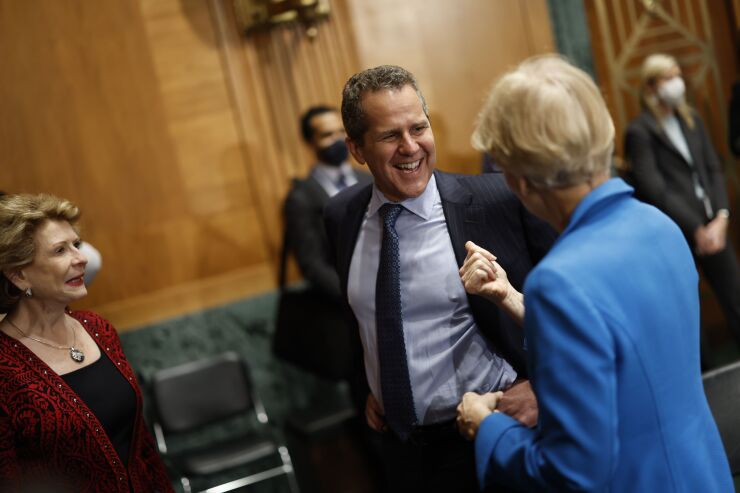
Federal Reserve Vice Chair for Supervision Michael Barr made the case for including multiple "exploratory" scenarios in the central bank's
In a speech delivered at the Federal Reserve Bank of Boston's Stress Testing Research Conference on Thursday afternoon, Barr highlighted several shortcomings within the Fed's
"The stress test needs to continue to evolve," Barr said. "Introducing multiple exploratory scenarios — both for the broader macroeconomic scenario and the global market shock for trading banks — would be beneficial for supervising potential risks on bank balance sheets."
Following his prepared remarks, Barr said the Fed intended to include global market shock scenarios and a "macroeconomic" exploratory scenario in next year's stress test.
Barr pointed to the failure of Silicon Valley Bank earlier this year as proof that the current approach to stress testing is insufficient. He noted that the Fed's severe scenario in the annual test tends to revolve around a recessionary environment in which unemployment is high, housing prices plummet and interest rates are falling, yet SVB failed despite none of those factors holding true.
He added that the current approach does not capture potential contagion of stress in the banking sector to other parts of the financial ecosystem, such as funding markets.
"These network effects may result in losses across the system not fully captured by our stress tests," Barr said. "While the severely adverse scenario is calibrated to historical recessions that have included contagion, our stress tests may not fully capture the evolving interconnections in today's financial system."
Barr said the current, limited approach to scenario testing is too uniform to effectively test the resilience of individual bank balance sheets. While he acknowledged the importance of transparency within the testing regime given its impact on capital requirements, Barr said the use of the same tests year after year "may encourage concentration across the system in assets that receive comparably lighter treatment in the test."
Under the current regime, if a stressful scenario causes a bank's common equity tier 1 ratio to fall below the level registered on the previous year's test, it must add the difference between the two years to its
However, the result of the enhanced testing could impact capital requirements for individual banks in

"Additional exploratory stress test scenarios could allow supervisors to better probe the internal risk management of firms and assess whether they are holding sufficient capital for their risks," Barr said.
Yet, while Barr said the current approach to scenario testing did not do enough to examine banks for a full complement of potential vulnerabilities, he added that it would not take a battery of additional tests to achieve that goal.
"This doesn't imply a large number of scenarios," he said. "Given the limited number of unique bank business models and variables that drive losses, a relatively small number of scenarios may be all that is required to capture a wide range of outcomes for the banking system."
Potential new scenarios could include an inflation-induced supply shock to the economy, rather than the demand-oriented disruption the Fed typically puts forth, Barr said, adding that the interplay between capital and liquidity is another area for potential examination.
Barr also said that he'd like to build upon the market shock included in this year's stress test, which he said delivered "a one-time shock to several thousand variables in bank trading books." He said there are other market factors that could be explored.
"This could include testing the exposure of firms to different directional risks, such as a sudden rise or fall in certain asset values, or to an unexpected divergence in values of correlated assets," he said. "It is particularly important for us to consider a range of market shocks because some concentrated counterparty exposures may be revealed only under certain scenarios."
Thursday's speech was
Following his prepared remarks, Barr discussed the topic of stress testing on stage with Lisa Ryu, a senior associate director with the Fed's division of supervision and regulation.
During the conversation Barr said the Fed is responsive to criticisms it has faced about its stress testing process in the past. He noted that recently expressed concerns about the test's treatment of loans backed by the Small Business Administration has led to changes in the calibration of next year's stress test.
But when Ryu asked about industry fears that the recently proposed changes to the risk-capital framework, in tandem with the Fed's stress test, would result in certain risks being "double counted," Barr said he did not see merit in the concern.
"I don't think that's the right way of thinking about it. Conceptually, the risk weights that we use in our static risk-weighted approach are designed to assess the minimum capital requirements for a firm and we use the stress test process to figure out what the buffer above that minimum should be," Barr said. "And so, just on a sort of conceptual basis, I don't think it's correct to say that it's double counting of those kinds of requirements."





